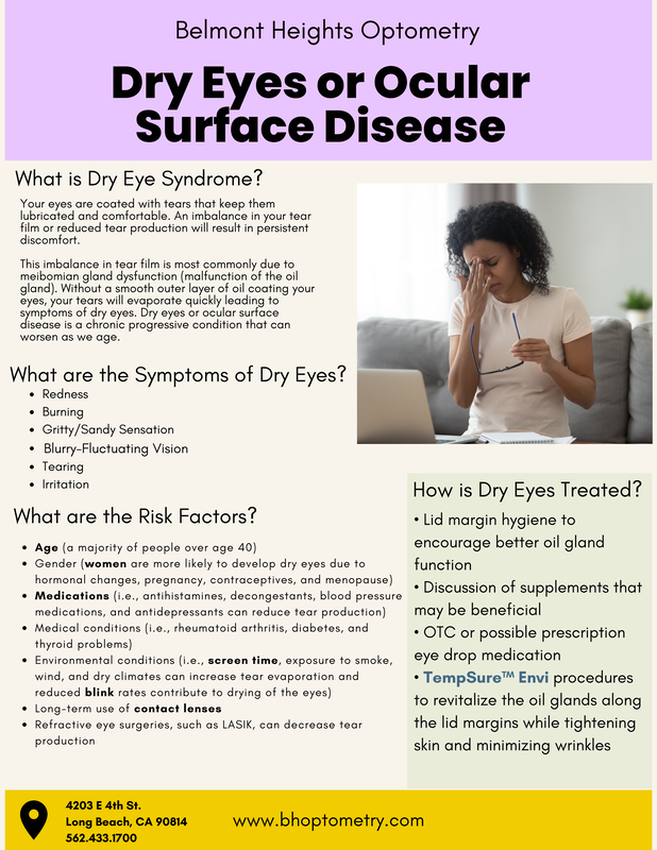- everyone who stares at a digital device
Start tomorrow off by getting rid of your daily dry eye treatments
Reduce or eliminate the need for artificial tears, warm compresses, or prescription medications.
Tempsure eye enviFDA approved to treat fine lines, wrinkles, and tighten skin. Treats the root cause of dry eyes, meibomian gland dysfunction (MGD). |
Clinically proven to treat dry eye symptomsForget about eye drops and warm compresses!
|
ICON IPLTargets inflammatory blood vessels, rosacea, that interfere with the functioning of meibomian glands.
|
Sight involves more than just 20/20 vision
Who should get yearly eye exams? EVERYONE especially individuals with diabetes, high blood pressure, elevated cholesterol, high refractive errors (high prescriptions), young children and the elderly.
DIABETES, HIGH BLOOD PRESSURE AND ELEVATED CHOLESTEROL
Diabetes, high blood pressure, and elevated cholesterol can affect the whole body including the eyes. Uncontrolled diabetes is becoming the leading cause of blindness in the U.S. These conditions can cause bleeding, leakage, blood vessel clotting, glaucoma, and early cataracts which can further lead to vision loss. Getting a yearly eye exam with a dilation is the best way to monitor for diabetic or hypertensive damage to the eyes.
HIGH REFRACTIVE ERRORS (MYOPIA OR NEAR SIGHTEDNESS)
A myopic (near-sighted) eye is longer than an emmatropic eye (an eye not requiring glasses to see). With a longer eye, the tissue on the retina must stretch out and is therefor thinner. This increases the chances of having a whole or tear on the retina that can lead to a retinal detachment. Only an eye exam with a dilation can properly detect this.
CHILDREN
Before starting school, all children should have their eyes examined!
A pediatrician or school nurse cannot detect all visual problems. A basic vision test that requires a child to read the letters on a chart may only alert parents to children that are near sighted. Children with strabismus (eye turns) , astigmatism, or those that are far-sighted (hyperopia) may not be detected. Without treatment, amblyopia or “lazy eye” may develop. Check and see how your pediatrician checks your child's vision. Do they have them cover up one eye at a time, do they have them try to read up close, can they tell if the child has any ocular conditions by getting a good view of the inside of their eyes?
Did you know that eye exams have lead to the detection of certain brain tumors, autoimmune conditions, diabetes, vascular disease, and even some STD's?
COMMON EYE CONDITIONS YOU SHOULD BE AWARE OF:
Glare sensitivity, blurry vision, tired & sore eyes, headaches, and dryness are all symptoms of prolonged screen time.
Glaucoma
Glaucoma is a hereditary condition that can affect your sight and can only be detected by an eye care professional. It is usually due to increased eye pressure that results in damage to nerve fibers in the back of your eyes. The result is first, reduced peripheral or “side vision” and eventually blindness in severe cases.
During our comprehensive eye exam, your intraocular pressure or “eye pressure” is measured, your visual fields or “side vision” is checked using an automated instrument, and the doctor looks at the appearance of your optic nerves (the cord that connects your eyes to your brain). After accessing these three components the doctor can determine your risk for glaucoma.
Macular Conditions
The macular region of the eye is essential to giving you your 20/20 vision. Any damage to this area will affect your central vision, the type of vision you use to read and distinguish detail in the world. The macula can have holes, swell up, and leak fluid, from injuries, surgeries, diabetes, hypertension, macular degeneration etc.
|
4203 E 4th Street. Long Beach, CA 90814
(562) 433-1700
|
